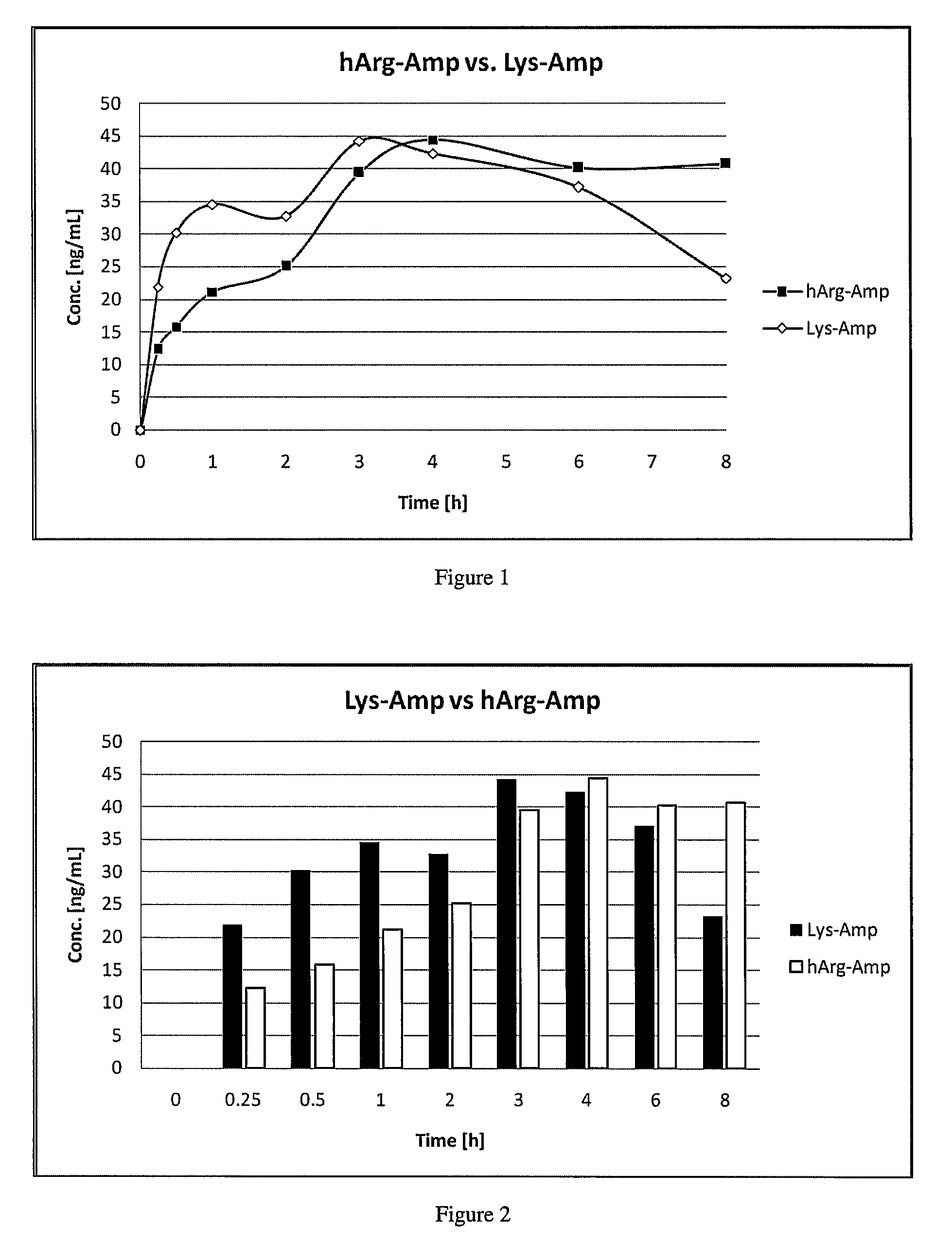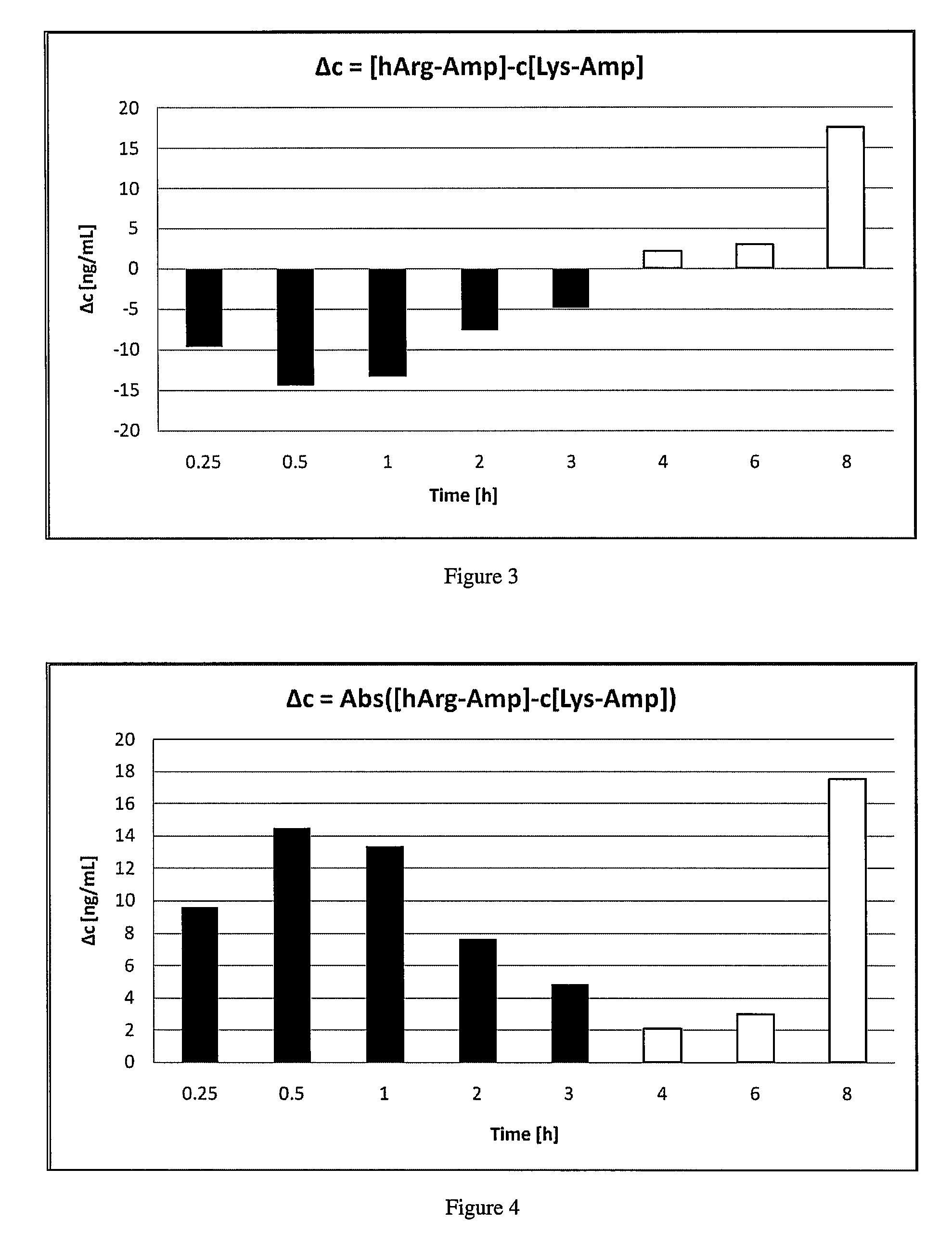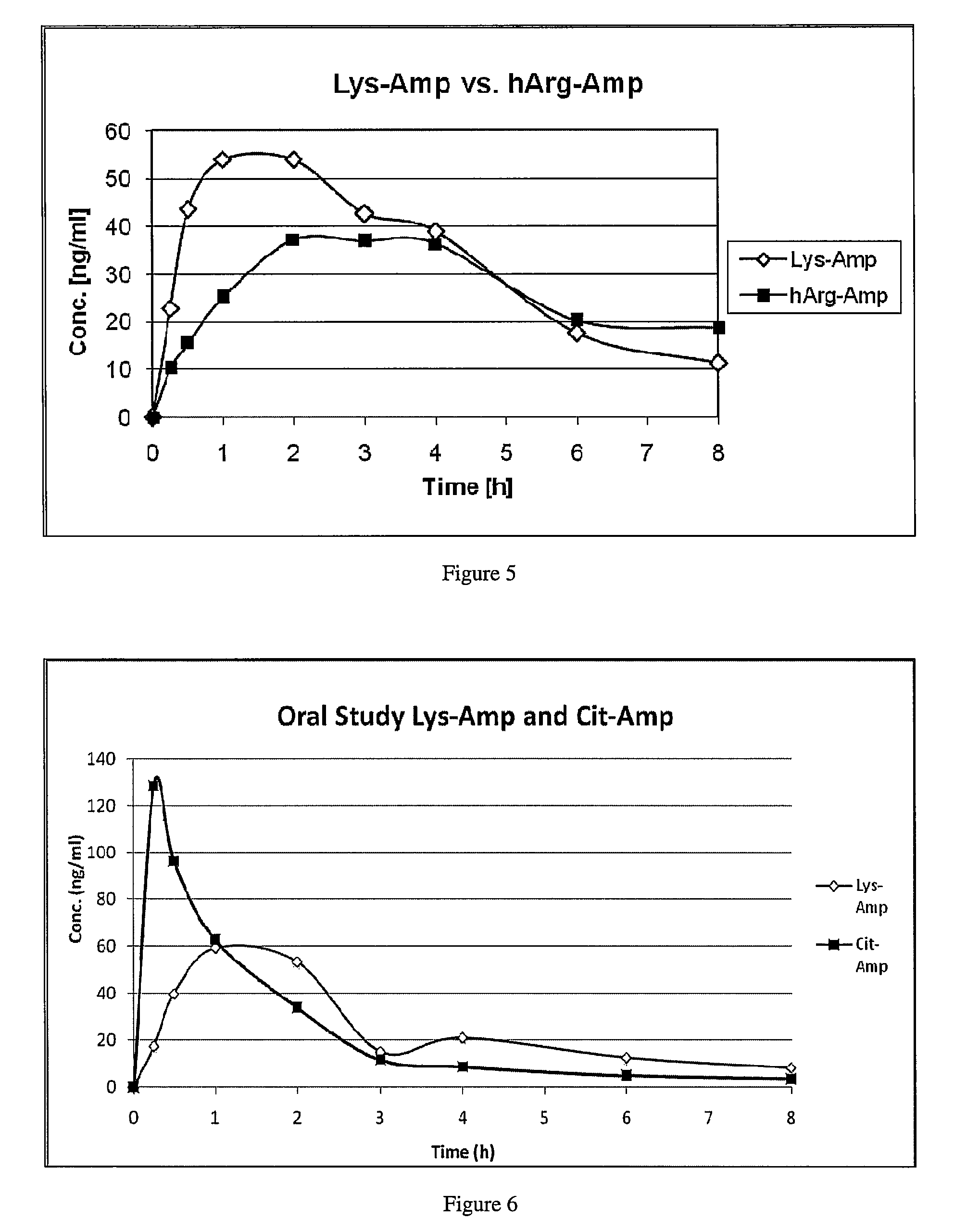Polar hydrophilic prodrugs of amphetamine and other stimulants and processes for making and using the same
a technology applied in the field of polar hydrophilic prodrugs of amphetamine and other stimulants and processes for making and using the same, can solve the problems of increased blood pressure and heart rate, significant reduction of abuse liability, and high and cardiovascular effects, so as to improve the duration of therapeutic effect, reduce the risk of abuse, and improve the effect of treatment
- Summary
- Abstract
- Description
- Claims
- Application Information
AI Technical Summary
Benefits of technology
Problems solved by technology
Method used
Image
Examples
example 1
Comparative Study of Pharmacokinetic Parameters of Released d-amphetamine Following Administration of a Polar Hydrophilic Prodrug of the Non-Standard Amino Acid Type (hArg-Amp) and a Standard Amino Acid Conjugate (Vyvanse™, Lys-Amp)
[0181]The pharmacokinetic parameters of d-amphetamine following oral administration of a non-standard amino acid conjugate of the present technology and a standard amino acid conjugate, Vyvanse™ (Lys-Amp), commercially available from Shire, Incorporated of Wayne, Pa. are studied in this example. The non-standard amino acid conjugate used in this example is the hydrochloride salt of hArg-Amp. The results are recorded in the table below:
[0182]
TABLE 1Non-standard amino AcidParameter% amp1Vyvanse ™ % total Amp2AUC0-8 h94%100%AUC0-4 h77%100%AUCinf95%100%Cmax76%100%Tmax400% 100%1Percent amphetamine released relative to Vyvanse ™ (at an equimolar concentration of amphetamine contained in the non-standard amino acid prodrug compared to the total amphetamine conta...
example 2
Preparation of Boc-hArg(NO2)-Amp
[0185]Boc-hArg(NO2)—OH (2.667 g, 8 mmol) was dissolved in DMF (25 ml). EDCI (2.30 g, 12 mmol), NHS (1.012 g, 8.8 mmol), d-amphetamine (1.269 g, 9.6 mmol) and DIEA (1.138 g, 8.8 mmol) were then added sequentially. The clear reaction mixture was stirred at room temperature for 16 hrs. The reaction mixture was quenched with pH 3 water (150 ml), and the product was extracted with EtOAc (3×50 ml). The combined extracts were washed with pH 3 water followed by saturated NaCl. The EtOAc layer was dried over anhydrous MgSO4. The product was recrystallized from EtOAc-Hexane two times to give 2.36 g of desired protected product.
[0186]The product was analyzed using 1H NMR (DMSO-d6)δ. The result shows 0.9-1.1 (m, 3H, Amp CH3), 1.1-1.2 (m, 2H, hArg γ CH2), 1.2-1.5 (m, 13H, Boc CH3, hArg β,δ CH2), 2.55-2.75 (m, 2H, Amp β CH2), 3.1 (m, 2H, hArg ε CH2), 3.75 (m, 1H, Amp α CH), 3.95 (m, 1H, hArg α CH), 6.65 (t, 1H, hArg guanidino NH), 7.1-7.3 (m, 5H, Amp Ar—H), 7.6-8.2...
example 3
Preparation of hArg-Amp-2HCl (l-homoarginine-d-amphetamine dihydrochloride)
[0187]Boc-hArg(NO2)-Amp (1.5 g) was dissolved in HPLC grade MeOH (120 ml) and to the clear solution was added the Pd—C catalyst (10%, Aldrich). A small stir bar was placed in the flask and the reaction mixture was stirred under a slow stream of hydrogen overnight after incorporating the 5-6N HCl in 2-propanol solution (1.5 ml). After the overnight reaction, the solution was filtered and the solvent evaporated. The white crystalline product was dried under vacuum to give 1.61 g of the Boc-hArg-Amp intermediate product.
[0188]The product (1.6 g) was dissolved in 80 ml of HPLC grade MeOH, and 5-6N HCl in 2-propanol (3.2 mL) was added to the solution. The reaction mixture was stirred overnight, solvent removed and re-dissolved in minimum amount of MeOH. The final product was crashed out with MTBE, and dried under vacuum at 30° C. for about 20 hours to yield 1.12 g of a white powder.
[0189]The white powder was analy...
PUM
 Login to View More
Login to View More Abstract
Description
Claims
Application Information
 Login to View More
Login to View More - R&D
- Intellectual Property
- Life Sciences
- Materials
- Tech Scout
- Unparalleled Data Quality
- Higher Quality Content
- 60% Fewer Hallucinations
Browse by: Latest US Patents, China's latest patents, Technical Efficacy Thesaurus, Application Domain, Technology Topic, Popular Technical Reports.
© 2025 PatSnap. All rights reserved.Legal|Privacy policy|Modern Slavery Act Transparency Statement|Sitemap|About US| Contact US: help@patsnap.com



